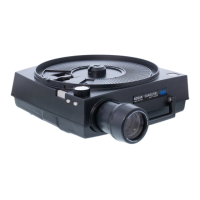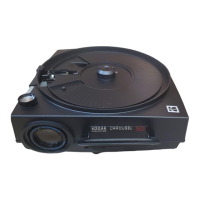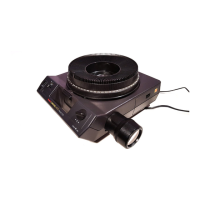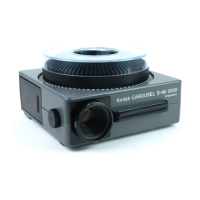Projection-Lamp Tips
• Your projector
is
equipped with a
HIGH-LOW
switch-use
of the
LOW
position gives lamp
life
up
to three times
as
long.
•
Rough
treatment of the projector
may
dam-
age
the projection lamp.
• Allow for unrestricted flow of air to the
in
-
take vents
on
the bottom of the projector,
and
the exhaust vent at the rear.
• Projector operation
on
line voltages above
120 volts greatly reduces the lamp life.
• Unplug the power cord before changing the
lamp.
SETTING
UP
POWER
AND
REMOTE-CONTROL
CORDS
Place the projector, bottom side up,
on
a table. Slide the latch
on
the
CORD-COMPARTMENT
DOOR
in
the direction
of
the arrow marked
OPEN
. Open
the cord-compartment door and remove the remote-control cord.
One
end of the power cord is permanently attached
to
the projector inside
the cord compartment. Remove the cord, checking to
see
that
it
rests
in
the cord RECESS where it emerges from the compartment. Then close
and latch the door. Turn the projector upright.
Plug the remote-control cord into the remote-control socket at the
rear of the projector. The
small
dot
on
the plug should
be
upward when
the plug
is
in
the socket.
Plug the power cord into a suitable electrical outlet.
Your CAROUSEL
Projector
operates on
110-
to 12S-volt,
60
Hz current
only
.
If
you
plug your projector into a different electrical source, the projector
may
be
damaged.
SCREEN
AND
SEATS
Because slides may
be
square, horizontal, or vertic
al
in
format
, a square
screen
is
usually most convenient. It should
be
large enough
for
easy
viewing by everyone present_
If
possible, your projector should
be
at the
same level
as
the center
of
the screen.
For easy viewing, your audience should not
be
farther
from the screen
than six times the longer dimension
of
the projected image.
See
the
chart listing projector-to-screen distances
on
the next page. Place the
seats .
as
close
as
possible to both sides of the beam thrown by the pro-
jector. The picture appears most
brilliant
and lifelike when you are
seated near the projected beam.
5

